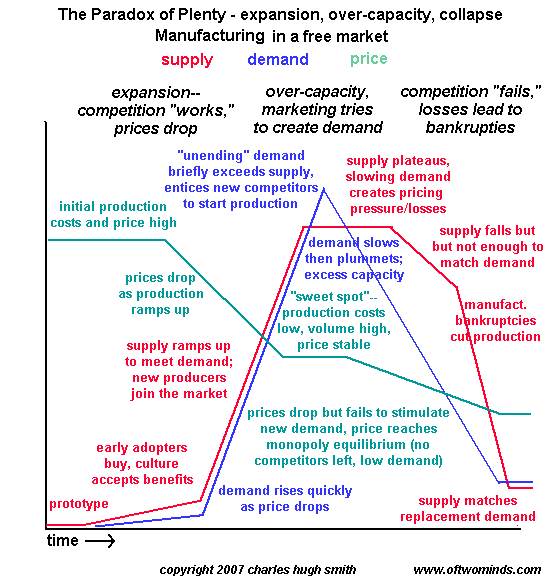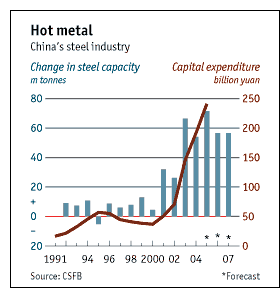

|
| weblog/wEssays archives | home | |
|
The Paradox of Plenty II (May 2, 2007) Yesterday we looked at the paradox of plenty in resources: as supply (of fish, oil, etc.) rises with new extraction/harvesting technologies, prices drop and vast quantities of the resources are squandered in the mistaken view that it will be abundant forever. With prices low, there is no market incentive to conserve or even look at the non-market costs such as species extinction. (The market doesn't care if you dynamite the reefs to harvest the fish or poison the water to extract the gold.) While you may think there is no "paradox of plenty" in manufactured goods--supply will always be tailored to match demand--there is indeed a paradox in manufacturing as well. As production ramps up to meet new demand, new producers join the frenzy. As demand slackens, the industry has too much capacity. Prices drop but this doesn't boost demand. Profits turn into losses and producers go bankrupt or are acquired, leaving either a monopoly or a cartel. 
Of course some companies excel at creating products which are unique and therefore the price can be maintained at a high level--Apple and the iPod, for instance. But eventually either demand for iPods will be satiated or competitors will match its "cool" factor and over-capacity will emerge. In industries like steel, there isn't much to differentiate manufacturers, and so these industries are especially vulnerable to over-capacity and collapse of profits. Take at look at this graph of China's skyrocketing steel production capacity: 
China is adding steel mills as if the demand will keep climbing at a permanently high rate. But where the demand rose quickly from 10 million tons to 20 million tons, the rise from 50 million tons to 60 million tons is much slower. At some point, demand for additional steel will top out, even in China. But as this chart demonstrates, capacity is being added at a tremendous rate--to meet a future demand which will not exist. Once over-capacity is a reality, then the producers enter the no-win tailspin of lowering production and cutting prices as each tries to grab market share and stay afloat. Eventually, weaker hands fold and are bought out, or shuttered and the production idled. As I have reported before, this has already come to pass in China in CRT televisions--a story reported in China Daily back in 2000. TV manufacturers were making more TV sets than the market could absorb, and price cuts had led to steep losses. The government had been forced to step in and fix prices. The same cycle is setting up in flat-screen televisions now, with manufacturers in Korea, Japan and China ramping up huge capacity to produce a "permanent abundance" of flat-screen TVs--an abundance which at some point will far exceed demand. Some industries have detoured this fate by creating "product cycles" in which the latest mobile-phone gimmicks (oops, I mean "features") spur new demand; and the auto industry has set up just such a replacement cycle as gas-hog vehicles will eventually have to be replaced by hybrids. But even industries which has prospered on ever-faster "product cycles" may find an exhaustion of demand as the global economy weakens. Consumers will realize the features on their current phone exceed their needs, and their Focus or Camry still has plenty of life left in it. Then the over-capacity being built in the global auto industry will suddenly become painfully visible--at least to the workers at plants which will be shuttered. So what's the paradox of plenty here? Over-capacity creates abundance, but also guarantees prices dropping below costs, leading to a collapse of profits and producers. In the euphoria of giant new markets like China, it's easy to be swept up and not notice that the cycle exists even in China, where the manufacturing sector is so prodigious that it can exceed global demand for virtually any product. For more on this subject and a wide array of other topics, please visit my weblog. copyright © 2007 Charles Hugh Smith. All rights reserved in all media. I would be honored if you linked this wEssay to your site, or printed a copy for your own use. |
||
| weblog/wEssays | home |